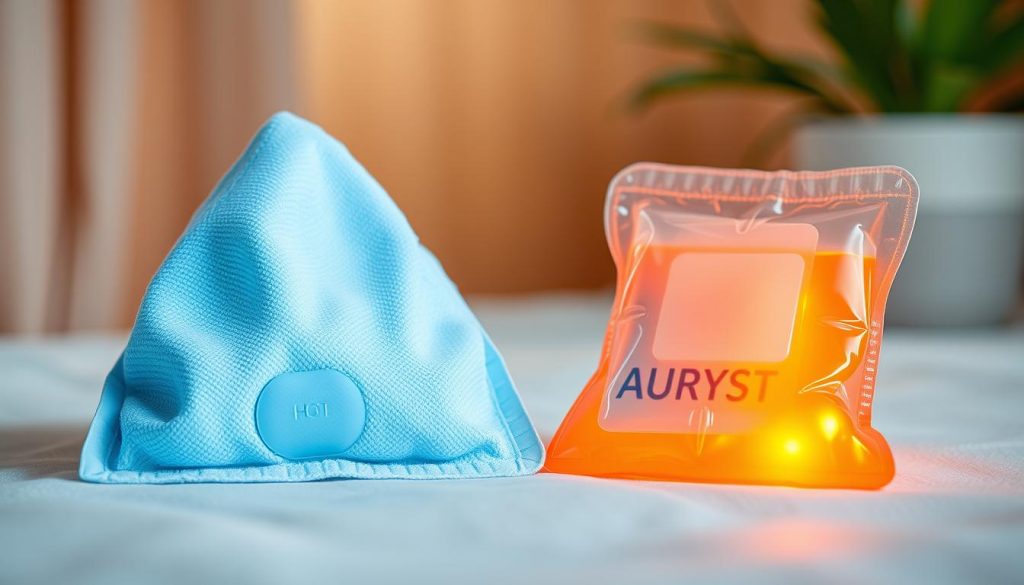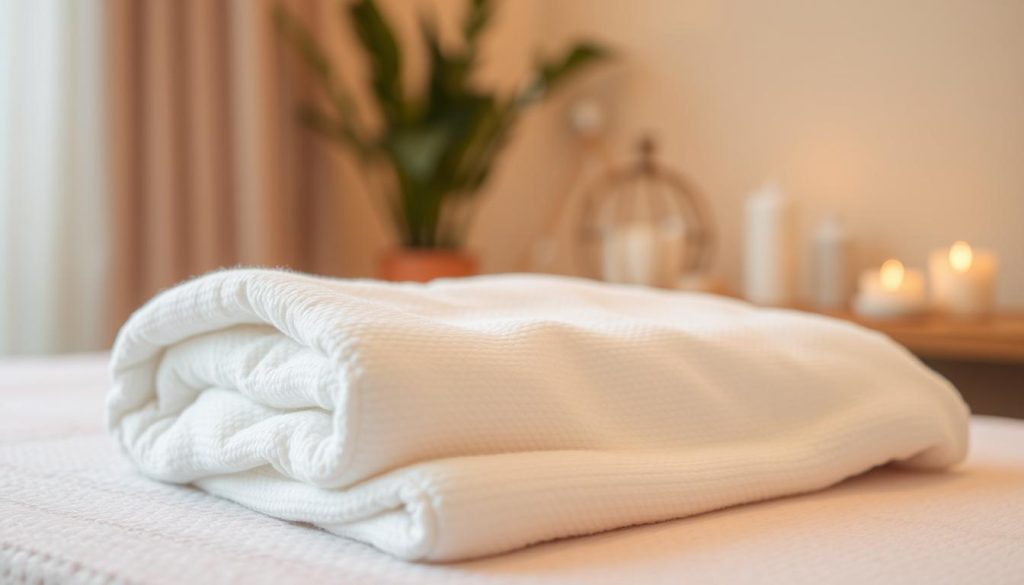Using a hot compress is a simple yet effective way to ease pain and relax muscles. It also helps the body heal naturally. But, are you getting the most out of this moist heat therapy? Many people don’t know the right way to use hot compresses safely and effectively.
In this article, we’ll show you how to prepare and apply hot compresses correctly. This will help you get the most healing benefits from this versatile remedy.
Key Takeaways
- Understand the therapeutic benefits of using hot compresses correctly
- Learn how to choose the right materials and maintain safe temperatures
- Discover when to use a hot compress for common ailments like muscle aches and strains
- Explore precautions and safety considerations to prevent burns or other injuries
- Maximise the effectiveness of hot compresses by following best practices
The Therapeutic Benefits of Hot Compresses
Hot compresses offer many health benefits. They help relax, ease pain, and boost blood flow. This makes them a powerful tool for healing.
Promoting Relaxation and Pain Relief
The warmth of a hot compress soothes the body. It relaxes tense muscles and eases discomfort. This can help with muscle aches, joint pain, and headaches.
Increasing Blood Flow and Healing
Moist heat from a hot compress boosts blood flow. This brings more oxygen and nutrients to the affected area. It speeds up healing and supports the body’s recovery.
| Condition | Hot Compress Benefits |
|---|---|
| Headache | Helps relax muscles and improve blood flow to alleviate pain |
| Bruises | Increases blood flow to promote healing and reduce swelling |
| Gout | Reduces inflammation and alleviates pain in the affected joints |
| Sprains and Strains | Enhances blood circulation to support the healing process |
Hot compresses offer many benefits. They can help you find relief and improve your well-being.
When to Use a Hot Compress
Hot compresses are great for easing many common issues. They can help with muscle aches, strains, inflammation, arthritis, menstrual cramps, and headaches. Knowing when to use one can make it a powerful tool for pain relief.
For muscle aches and strains, a hot compress boosts blood flow. This helps the area heal faster and feels less sore. They’re also good for joint inflammation and arthritis, easing stiffness and pain.
For menstrual cramps, applying a hot compress to your lower abdomen can be very soothing. Some people find that hot compresses help with headaches, especially those from neck and shoulder tension.
It’s important to know what you’re treating and where to apply the compress. By focusing on the right spots with the right heat, you can get the most benefit and find the relief you’re looking for.
“Hot compresses are a simple and natural way to address a wide range of common health concerns. With a little knowledge and the right technique, you can tap into their healing power.”
Correct hot compress: Preparing and Applying the Compress
Getting a hot compress right is key for its benefits. You need to pick the right stuff and keep the heat safe.
Choosing the Right Materials
For warm towel application or heat pack application, material choice matters. A good heat and moisture compress boosts treatment effects. Here are some options:
- Soft, absorbent towels: Great for a warm, moist compress.
- Reusable heat packs: Heat them up in the microwave for a steady temperature.
- Damp washcloths: Simple and effective for small areas or targeted temperature regulation.
Maintaining Safe Temperatures
It’s vital to keep the compress temperature right. Too hot can burn or hurt. Here’s how to avoid it:
- Check the compress’s heat by holding it against your wrist or elbow.
- Make it warm but not too hot.
- Keep checking the compress to make sure it stays comfortable.
By doing these steps, you’ll get a safe and effective heat and moisture compress use. This way, you get the most benefits while staying comfortable.
Treating Common Ailments with Hot Compresses
Hot compresses are great for treating many common problems, especially muscle aches and strains. They use moist heat to relax the area and help the body heal naturally.
Muscle Aches and Strains
Hot compresses can ease muscle pain and help injuries heal faster. The warmth boosts blood flow, bringing nutrients and oxygen to damaged tissues. This is good for sprains, pulls, and muscle soreness.
To use a hot compress for muscle aches, place the warm cloth on the sore spot for 15-20 minutes, a few times a day. It can lessen pain, reduce swelling, and aid in healing.
| Condition | Benefit of Hot Compress |
|---|---|
| Muscle Aches | Increases blood flow, reduces pain and stiffness |
| Muscle Strains | Accelerates healing by delivering nutrients to damaged tissues |
| Joint Pain | Reduces inflammation and improves mobility |
While hot compresses are helpful for muscle issues, be careful not to burn yourself. Always check the temperature and talk to a doctor if the pain doesn’t go away.
Precautions and Safety Considerations
Using hot compresses safely is key. They can help with muscle aches and relaxation. But, it’s important to be careful to avoid skin issues or burns.
Checking the hot compress’s temperature is crucial. High temperatures can cause burns, especially for those with sensitive skin. Always test the temperature on a small area first.
- Maintain a comfortable temperature, typically between 38°C and 43°C (100°F to 110°F), to avoid the risk of burns.
- Be mindful of your skin’s sensitivity and adjust the temperature accordingly.
- Discontinue use if you experience any discomfort or notice signs of skin irritation.
Also, drink plenty of water when using hot compresses. The heat can dry out your skin. Drinking water helps keep your body hydrated and regulates temperature.
| Precaution | Importance |
|---|---|
| Temperature Monitoring | Prevent burns and skin sensitivity |
| Hydration | Maintain optimal temperature regulation |
| Skin Sensitivity | Adjust temperature and duration accordingly |
By following these safety tips, you can enjoy the benefits of hot compresses safely. This ensures a comfortable and safe experience.
Hot or Cold: Choosing the Right Compress for Your Needs
Choosing between a hot or cold compress can greatly affect your treatment’s success. It’s important to know the benefits of each to get the best results.
For headaches or bruises, a cold compress is better. It cools, reduces swelling, and eases pain. On the other hand, a hot compress is good for gout or inflammation. It increases blood flow, relaxes muscles, and eases discomfort.
To pick the right compress, follow these tips:
- For headaches or bruises, choose a cold compress to reduce swelling and numb pain.
- For muscle aches, joint pain, or stiffness from gout, use a hot compress.
- Hot compresses help reduce inflammation and aid in healing.
| Condition | Hot Compress | Cold Compress |
|---|---|---|
| Headache | ❌ | ✔️ |
| Bruises | ❌ | ✔️ |
| Gout | ✔️ | ❌ |
| Inflammation | ✔️ | ❌ |
Knowing the benefits of hot and cold compresses helps you choose the best treatment. This ensures your care is effective and tailored to your needs.

“The application of heat or cold can make a significant difference in the healing process, so it’s important to choose the right compress for the job.”
Tips for Maximising the Benefits of Hot Compresses
To get the most out of hot compress therapy, timing and duration are key. Also, combining hot compresses with other therapies can boost pain relief and muscle relaxation.
Timing and Duration
For effective hot compress therapy, use the compress for 15-20 minutes. Repeat this several times a day as needed. This lets the heat deeply penetrate tissues, boosting blood flow and aiding healing.
Combining with Other Therapies
Pairing hot compress therapy with other treatments can enhance benefits. For example, using a hot compress with gentle stretching or massage can relax muscles and ease pain. Also, combining it with pain relief medications or topical analgesics can offer more relief for muscle aches, joint pain, or gout.
Find the right balance of timing, duration, and therapies for your needs. Experiment and adjust until you find the best hot compress routine for your health.
| Condition | Recommended Hot Compress Therapy |
|---|---|
| Headache | Apply a hot compress to the forehead or back of the neck for 15-20 minutes to help relieve tension and improve blood flow. |
| Bruises | Use a hot compress to increase blood flow and promote healing, then switch to a cold compress to reduce swelling and inflammation. |
| Gout | Apply a hot compress to the affected joint to help reduce pain and inflammation associated with gout. |
| Muscle Inflammation | Treat muscle aches and strains with a hot compress to increase circulation and reduce swelling. |
The Science Behind Moist Heat Therapy
Understanding the science of moist heat therapy reveals its amazing benefits. It uses heat and moisture to help the body heal. This method works by changing how the body responds to pain and inflammation.
Moist heat therapy boosts blood flow. The heat makes blood vessels wider, bringing more oxygen and nutrients to the affected area. This helps the body heal faster, reducing pain and swelling.
The warmth and moisture from a hot compress also calm nerve endings. This can ease muscle aches, joint pain, and headaches. The mix of better blood flow and less nerve sensitivity makes you feel relaxed and well.
To get the most from moist heat therapy, knowing the right temperatures and how to apply it is key. Finding the perfect balance between heat and safety is important. It ensures you get the benefits without risking burns or scalds.
Exploring the Science of Moist Heat Therapy
- Increased blood flow and circulation
- Reduced inflammation and pain management
- Soothing effect on nerve endings
- Balancing heat and safety for optimal results
Learning about the science behind moist heat therapy opens up its full potential. It lets you tackle a variety of health issues with confidence and success.
| Physiological Effect | Impact |
|---|---|
| Increased Blood Flow | Accelerates healing, reduces inflammation |
| Nerve Soothing | Provides relief from muscle aches, joint pain, and headaches |
| Balancing Heat and Safety | Maximises therapeutic benefits while avoiding risks |
Conclusion
Learning how to use a hot compress right can be very helpful. It can ease muscle pain and reduce swelling. This makes it a great way to feel better and stay healthy.
It’s important to know when and how to use a hot compress. This is true for treating headaches, bruises, or gout. By using it correctly, you can get the most out of this healing method.
Next time you’re feeling sore or need to recover, try a hot compress. It’s a simple way to help your body heal. With the right steps, you can use moist heat therapy to improve your health.
